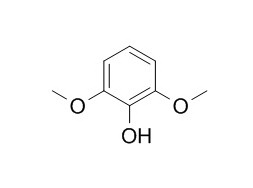Syringol
Syringol and phenol have modifying effect on NMOR formation in vivo to be similar,
the effect of food on NMOR levels in blood is more important than that of the modifiers.
Inquire / Order:
manager@chemfaces.com
Technical Inquiries:
service@chemfaces.com
Tel:
+86-27-84237783
Fax:
+86-27-84254680
Address:
1 Building, No. 83, CheCheng Rd., Wuhan Economic and Technological Development Zone, Wuhan, Hubei 430056, PRC
Providing storage is as stated on the product vial and the vial is kept tightly sealed, the product can be stored for up to
24 months(2-8C).
Wherever possible, you should prepare and use solutions on the same day. However, if you need to make up stock solutions in advance, we recommend that you store the solution as aliquots in tightly sealed vials at -20C. Generally, these will be useable for up to two weeks. Before use, and prior to opening the vial we recommend that you allow your product to equilibrate to room temperature for at least 1 hour.
Need more advice on solubility, usage and handling? Please email to: service@chemfaces.com
The packaging of the product may have turned upside down during transportation, resulting in the natural compounds adhering to the neck or cap of the vial. take the vial out of its packaging and gently shake to let the compounds fall to the bottom of the vial. for liquid products, centrifuge at 200-500 RPM to gather the liquid at the bottom of the vial. try to avoid loss or contamination during handling.
OENO One2023, 57:3.
Asian J Beauty Cosmetol2024, 22(1): 103-112.
VNU Journal of Science2023, 39(2):24-33.
Evid Based Complement Alternat Med.2021, 2021:8707280.
J Korean Soc Food Sci Nutr2023, 52(11):1101-1110
Hong Kong Baptist University2023, 048330T.
VNU Journal of Science: Med.& Pharm. Sci.2022, 38(2):2588-1132.
Int J Mol Sci.2024, 25(2):764.
Molecules.2017, 22(12)
ACS Pharmacol Transl Sci.2024, 7(2):395-405.
Related and Featured Products
Carcinogenesis. 1986 Jun;7(6):867-70.
Effects of phenol and 2,6-dimethoxyphenol (syringol) on in vivo formation of N-nitrosomorpholine in rats.[Pubmed:
3708751]
We determined the effects of phenol and 2,6-dimethoxyphenol (Syringol) on N-nitrosomorpholine (NMOR) formation in rats given morpholine and nitrite by gavage.
METHODS AND RESULTS:
At 30 min post-gavage the recovery (from the stomach, duodenum and blood) of 564 micrograms NMOR was six times higher when administered to rats by gavage with 2 g of semipurified diet (SPD) than when given without food. Rats were gavaged with 12 mg each of morpholine, one of the modifiers and nitrite and examined 30 min later. Syringol decreased the amount of NMOR in both the stomach and blood by 89%, while phenol had no effect. We compared these results with those obtained with ascorbic acid and thiocyanate. The effect of ascorbic acid was similar to that of Syringol. However, thiocyanate increased the amount of NMOR in the stomach and blood 2.7- and 4-fold, respectively. When 2 g of SPD was administered to rats by gavage, together with the precursors, Syringol and ascorbic acid blocked NMOR formation in the stomach by 58 and 45%, respectively, and thiocyanate enhanced the yield 1.5-fold. The effect of phenol was not significant for the stomach and blood and that of the other modifiers was not significant for blood. Administration of the reactants together with food decreased the NMOR level in blood 155-fold relative to controls (no food), suggesting that food decreased the absorption rate over a 30-min period.
CONCLUSIONS:
These results demonstrate the modifying effect of phenol and Syringol on NMOR formation in vivo to be similar to that observed in a previous in vitro study, and show that the effect of food on NMOR levels in blood was more important than that of the modifiers.
J Chem Phys. 2013 Oct 14;139(14):144313.
Ultraviolet spectroscopy of fundamental lignin subunits: guaiacol, 4-methylguaiacol, syringol, and 4-methylsyringol.[Pubmed:
24116625]
Ultraviolet spectroscopy of the G- and S-type lignin subunits, guaiacol (G) and Syringol (S), along with their para-methylated derivatives 4-methylguaiacol (4-MG) and 4-methylSyringol (4-MS), has been carried out in the cold, isolated environment of a supersonic jet.
METHODS AND RESULTS:
The excitation spectra and dispersed fluorescence (DFL) spectra of G and 4-MG show strong S0-S1 origins and Franck-Condon activity involving both the ring modes typical of aromatic derivatives, and the four lowest frequency out-of-plane modes (a") and lowest in-plane mode (a') involving the OH and OCH3 groups. The four low-frequency out-of-plane modes undergo extensive Duschinsky mixing between the ground and excited state. In 4-MG, combination bands involving methyl rotor levels with out-of-plane modes appeared with surprisingly high intensity, indicating a high degree of hindered rotor-vibration coupling in both S0 and S1. These mixing effects accompany the change in geometry upon π-π∗ electronic excitation going from a planar ground state to a non-planar excited state. Time-dependent density functional theory (TDDFT M05-2X∕6-311++G(d,p)) calculations predict a geometric distortion along the out-of-plane oxygen flapping coordinate, yielding a double minimum potential in S1 with a barrier to planarity of 195 cm(-1) in G. The excitation spectrum of S and 4-MS showed a much higher degree of spectral congestion and a larger geometry change evident by a shifted intensity distribution peaking ∼300 cm(-1) above the electronic origin. TDDFT calculations predict a larger geometry change in S compared with G, with the OH and H-bonded methoxy groups displaced in opposite directions above∕below the ring plane. Dispersed fluorescence from all S1 excited state levels in S∕4-MS yield only broad emission peaking far to the red of the excitation wavelength (-4500 cm(-1)). Several hypotheses regarding the source of this broad, redshifted emission were tested, but the cause remains unclear. p-Methylation was found to significantly redshift the UV absorption in both 4-MG and 4-MS, and methyl rotor transitions were assigned in both allowing for the determination of the shape and barrier heights of their respective potentials.
CONCLUSIONS:
These results provide a foundation for the discrimination of G- and S-chromophores in lignin oligomers, and demonstrate the potential for site-selective absorption.



